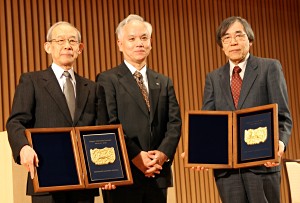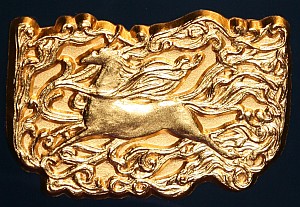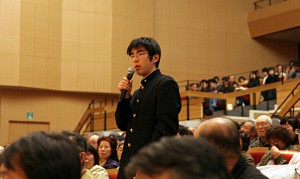Features
Features
The meaning of life
- ツイート
- 2010/05/27
Nagoya University Lecture, Toyoda Auditorium, 31 March 2010
The Nagoya University Lecture is arguably the most prestigious event in the institution's annual calendar and an opportunity for it to recognize the cream of its highest-achieving academic statesmen. Now in its fourth year, the lecture is traditionally given by one or more internationally acknowledged scientists with strong connections to Nagoya University. Previous lecturers have included Sumio Iijima, nanotube pioneer and member of the prestigious Institute of Advance Research (IAR) at Nagoya University, and British-born 1996 Chemistry Nobel laureate Sir Harold Kroto. In 2009, three lectures were held to honor 2008 Chemistry Nobel laureate Osamu Shimomura, and Toshihide Maskawa and Makoto Kobayashi, who shared the 2008 Nobel Prize in Physics, all of whom spent their formative years at Nagoya University. The three continue to contribute to the academic life of the university as IAR academy members, election to which is often preceded by being selected to give a Nagoya University Lecture.
 In addition to being a central event in the academic life of the university, the Nagoya University Lecture is also the highest-profile conference in the public life of the institution and a key element in its public scientific outreach program. As such, the lecture introduces cutting-edge research in a way that is both lively and highly accessible to non-specialists with special emphasis on stimulating the enthusiasm of young people towards science. In keeping with this aim, a signification proportion of the audiences for the lecture -- around 15% in 2010 -- are students drawn from local junior high and high schools.
In addition to being a central event in the academic life of the university, the Nagoya University Lecture is also the highest-profile conference in the public life of the institution and a key element in its public scientific outreach program. As such, the lecture introduces cutting-edge research in a way that is both lively and highly accessible to non-specialists with special emphasis on stimulating the enthusiasm of young people towards science. In keeping with this aim, a signification proportion of the audiences for the lecture -- around 15% in 2010 -- are students drawn from local junior high and high schools.
The 2010 Lecture, held in the Toyoda Auditorium -- the iconic centerpiece of the Nagoya University campus -- was entitled 'What is life? From DNA to the formation of the body' and was delivered by two distinguished speakers: Masahiro Sugiura, the internationally renowned geneticist and molecular biologist, and Masatoshi Takeichi, a pioneering developmental biologist and discoverer of the molecular basis governing cellular adhesion. Both of the 2010 lecturers have strong ties with Nagoya University, having joined its Graduate School of Science in 1960 and 1966, respectively. Both were born and brought up locally and the subject of their local roots was touched upon by Nagoya University President Michinari Hamaguchi in his welcoming address, when he spoke of his immense pride in being able to welcome two such distinguished scientists who were by any measure 'made in Nagoya'.
The first of the 2010 Nagoya University Lectures, given by Sugiura, who is a former director of the Center for Gene Research at Nagoya University and is now professor emeritus, was entitled 'Determining the total structure of the chloroplast genome'. In his wide-ranging talk, Suigura spoke engagingly about his early experiences in the Faculty of Science at Nagoya University in the make-do-and-mend days of the early 1960s and his decision to leave his alma mater for the University of Illinois even before he had obtained his PhD -- a course of action almost unthinkable for a young Japanese scientist at the time. He also talked about his strategic switch in mid-career away from studying gene expression of a colon bacterium to take up the challenge of unraveling the genome of the tobacco plant, a decision in part prompted by research he carried out at the Basel Institute for Immunology with longstanding collaborator Susumu Tonegawa, work for which the latter was awarded the 1987 Nobel Prize for Physiology or Medicine.
 The focus of Sugiura's lecture was his desire to examine the entirety of the genome rather than focusing on the function of specific genes within it. Until recently it was believed that large sections of the DNA making up the genome carried no genetic information at all and was simply genetic 'garbage' to be discarded. Sugiura's work focusing on the tobacco chloroplast genome has shown that this is far from the case. This leap in understanding has come about by moving away from a model that focuses on identifying the base sequence associated with a particular gene to one that maps the entire genome and then looks for gene-coding sequences within it.
The focus of Sugiura's lecture was his desire to examine the entirety of the genome rather than focusing on the function of specific genes within it. Until recently it was believed that large sections of the DNA making up the genome carried no genetic information at all and was simply genetic 'garbage' to be discarded. Sugiura's work focusing on the tobacco chloroplast genome has shown that this is far from the case. This leap in understanding has come about by moving away from a model that focuses on identifying the base sequence associated with a particular gene to one that maps the entire genome and then looks for gene-coding sequences within it.
Following a ceremony in which the two 2010 Nagoya University Lecturers were each presented with commemorative plaques featuring the emblem of the IAR -- the kirin, a mythical Chinese chimerical creature symbolizing wisdom -- by the Nagoya University president, the second half of the program commenced with the lecture by Takeichi entitled 'Solving the mystery of how cells self-organize tissues'. Takeichi is a former professor of the Graduate School of Biostudies at Kyoto University and the current director of the Center for Development Biology at RIKEN, Japan's premier government research institution. He is also a recipient, along with Sugiura, of the Person of Cultural Merit award. His lecture addressed the fascinating phenomenon of cellular self-organization, the process by which individual cells join together to form more complex entities. He demonstrated the remarkable ability of certain cellular structures to regenerate themselves after disruption, and examined the genetic pathways that govern the correct organization of the many structural units in advanced multicellular organisms such as the vertebrates. In particular, Takeichi focused on the role played in the organization of biological systems by a family of transmembrane proteins that form liaisons between adjacent cells in the presence of calcium ions. The existence of these proteins, known as cadherins, was discovered serendipitously by Takeichi in 1974 when working as a research fellow at the Carnegie Institution Department of Embryology. The subsequent investigation and determination of their mode of action in the intervening years has revolutionized the field of cell biology in general and cell adhesion in particular.
 Although addressing somewhat different topics in their lectures, both speakers stressed the vital role played by free thinking when pursuing research themes -- a point taken up in the question-and-answer sessions that followed both lectures. The speakers fielded questions on a variety of topics from specific points of science to more general enquiries. In one such exchange, Sugiura was asked for career advice by a young would-be life scientist Kohei Noda. "I was really fascinated by your talk, but to be honest I haven't studied that much biology," said the junior high-schooler, "and I'm a bit unsure as to what I should take an interest in, in the future. Do you have any advice?" A short pause, then the reply: "Being unsure is extremely important. So don't worry about being unsure. You should try a lot of different things and eventually you'll find what it is that interests you, and that's the way you should go." Good advice to the young and a neat summary of the approach to research and learning that is the hallmark of academic life at Nagoya University.
Although addressing somewhat different topics in their lectures, both speakers stressed the vital role played by free thinking when pursuing research themes -- a point taken up in the question-and-answer sessions that followed both lectures. The speakers fielded questions on a variety of topics from specific points of science to more general enquiries. In one such exchange, Sugiura was asked for career advice by a young would-be life scientist Kohei Noda. "I was really fascinated by your talk, but to be honest I haven't studied that much biology," said the junior high-schooler, "and I'm a bit unsure as to what I should take an interest in, in the future. Do you have any advice?" A short pause, then the reply: "Being unsure is extremely important. So don't worry about being unsure. You should try a lot of different things and eventually you'll find what it is that interests you, and that's the way you should go." Good advice to the young and a neat summary of the approach to research and learning that is the hallmark of academic life at Nagoya University.
NU Research
(English)

